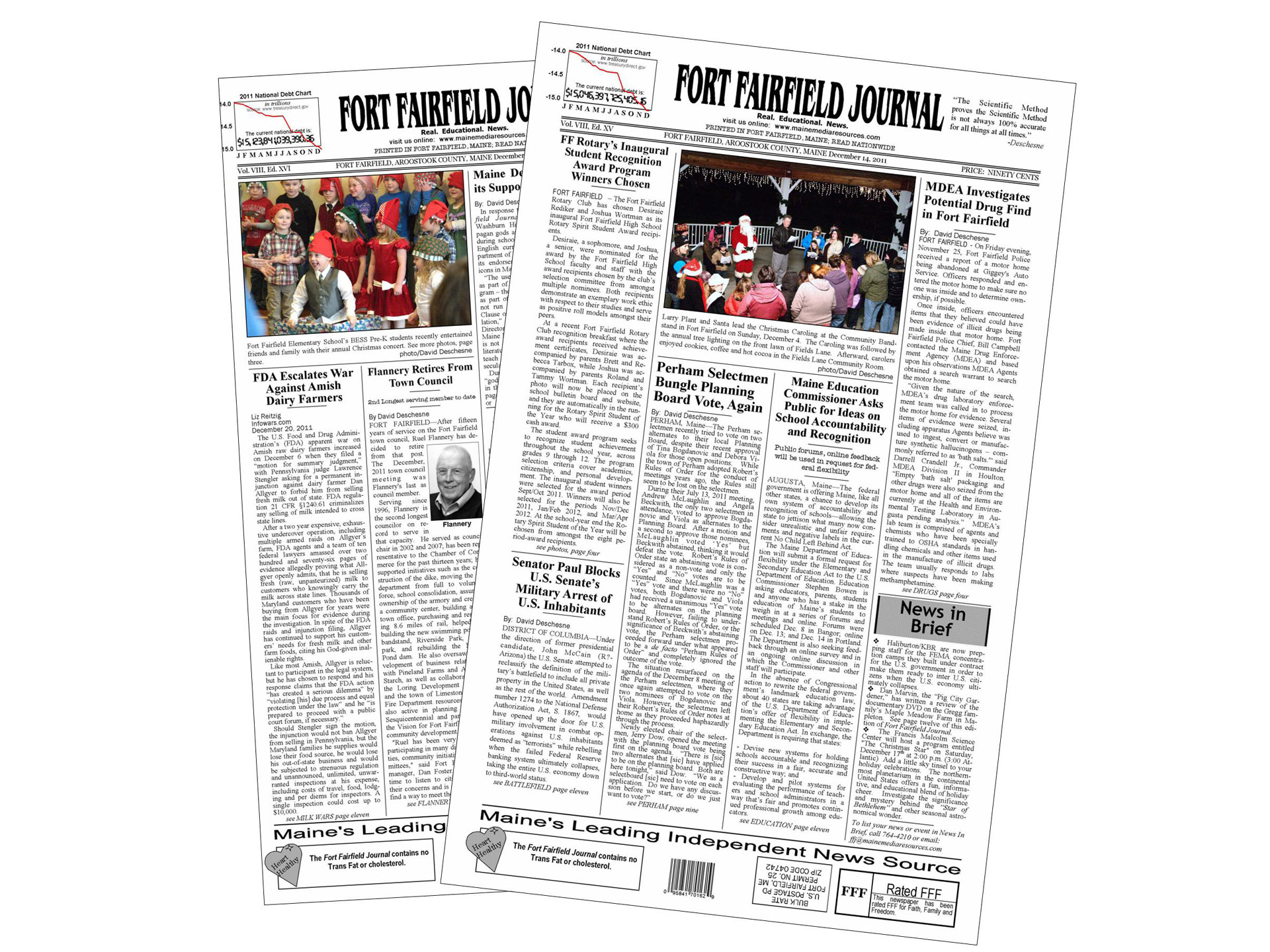

From the Editor

By: David Deschesne
Editor/Publisher,
Fort Fairfield Journal
February 21, 2024
As many of you already know, I’ve been involved with sound systems since my Junior year in High School and have been providing sound systems in this area now for nearly 37 years (in addition to writing and publishing this newspaper for the past 20 years). I attended a vocational school in Chillicothe, Ohio called The Recording Workshop in 1987 to learn the equipment and the art of recording (I did not attend any college or university to learn journalism or newspaper publishing). The Recording Workshop was a $4,000, seven-week course which was partially paid for with a $1,000 scholarship from Fort Fairfield Alumni Association. I paid for the rest out of pocket—no bank loans!
When I came back to The County I realized there wasn’t going to be much work for a hungry recording engineer so I put my focus on live sound production and equipment rentals. The audio mixing console shown on this page is a Allen & Heath GL2400 32-channel board I acquired in the early 2010s. I have since placed it in storage and replaced it with a more compact Allen & Heath SQ-5 which has all the same capabilities but is a digital console so all the knobs are “virtual” on a touch screen. But, this older analog board with all the physical knobs will at once help me to make my point and help the reader to visualize it.
Knob Tweakers
I’m sure many of my readers have attended concerts or musical productions where a large mixing console like this is used. Sometimes, especially in the case of a young, untrained sound engineer, you might notice the technician hovering over the mixing console furiously tweaking the knobs all through the show seemingly as if believing if he stopped tweaking, “the patient would die.” This is a sign of someone who has no idea what they are doing and are hoping to fake it long enough to trick people into thinking they do. Many politicians exhibit this same behavior with the clownish and often-times destructive laws they write and dupe their comrades into passing, much to the expense of the public they are supposed to be serving. The solution is for both to read their respective operator’s manuals and learn what the rules are before they take on their respective jobs.


The Audio Mixer Operator’s Manual
While all of the knobs in the above picture may seem intimidating, they are really 1 set duplicated 32 times (plus subgroups, a matrix section and Left/Right Master output). So, the operator’s manual only needs to give the rules for one input channel and once the technician masters those rules, he/she can apply that knowledge to all the others.
In referring to the enlarged channel strip shown here on this page, I will give a brief overview of the rules to reduce the mystique of the process.
Starting at the top there is a +48V switch which is used to apply 48 volts DC to a connected condenser microphone to enable it to provide signal (a condenser mic consists of two charged thin metallic plates; one is fixed and the other is a thin film that can vibrate with sound; the 48 volts charging the plates varies with the sound vibration due to the changing capacitance between the plates and thus creates a fluctuating voltage that can be further amplified by the mixer and sound ultimately comes out of the speaker system) this switch can remain off with a dynamic mic, which is a mic consisting of a moving coil of wire in a magnetic field and thus creates its own voltage internally. The next button down is the polarity button which reverses the electrical polarity of the microphone input to help with some feedback reduction or noise cancellation of resonant frequencies on or around the stage. Next is the Gain knob which sets the input level of the channel strip. It is usually adjusted so the clip light flickers occasionally to make sure there is a enough signal coming into the input channel to help with noise reduction but not so much it overloads the circuitry. Next is the equalizer section. Think of this as the bass and treble, or tone controls, on your home stereo, only more frequency ranges to choose from. The knobs labeled -15 and +15 are the boost/cut knobs. Those knobs with frequency ranges allow the technician to sweep that particular band of audio frequencies to choose which frequency to boost or cut (this is a feature found in parametric equalizers). This ability to sweep through and select frequencies comes in handy for feedback reduction, or filling out the tone of an instrument or voice. Then we have the Auxiliary (AUX) knobs. When in the PRE position, the signal is output to the AUX outputs pre- (before) the output fader. This configuration is used to send outputs to stage monitors, or a video’s audio feed, independently of the output mix. When the AUX knob is selected to the POST (after the output fader) position, it is used for sending that channel’s signal to a signal processor like a reverb or effects unit. Since it is Post-fader, when the fader is turned up or down, the input level to the effects unit is concomitantly adjusted as well. This particular mixing console can allow up to six monitor outputs or four monitor and two effects units (you can still insert an effects unit on an individual input channel in the event all AUX knobs are being used for monitor sends).
Next, we have the PAN knob. This is the “balance” control on your home stereo and adjusts the signal between the left and right outputs. Then, there is a MUTE button which allows the technician to mute the channel when it’s not being used, then a PFL—or Pre Fader Listen—button which allows the technician to single out that particular channel and listen to it in a set of headphones. Finally, we have the output fader which adjusts the overall level of the input channel and a set of selection buttons to route the signal to either the Left and Right outputs or to any of 4 subgroups to collate several inputs—such as the group of microphones on a large drum set to a single sub-group fader before the final mix down to Left and Right.
As you can see, there are a lot of moving parts on the input channels, but you only need to know the rules for one of them and then you know how to use all the rest of them. Knowing the rules is important. But, the technician who doesn’t know or understand the rules will stand there throughout the show and endlessly tweak, trying to figure out what they are doing. A properly trained technician will have all that tweaking done during the sound check and by the time the show starts, will have an easy time overseeing the board, only needing to make minor adjustments to correct for feedback issues as they arise, or perhaps to boost the signal level of a soloist. By the time the show starts, the tweaking should be all finished.
But, how should we deal with technicians who are using the mixing console improperly? Should we ban or heavily regulate the sale of mixing consoles, or work on improving the person operating them? How do you think a politician would answer that?
Politicians’ Operator’s Manual
I gave you all that crash course in audio mixing to provide some context for this part of my discussion. The Operator’s Manual for politicians is the State and Federal Constitutions. While some people think the Constitution is a “living document” and can/should be interpreted (more like interpolated, these days, the way things are going) as the public demands, that’s not the real purpose, nor should it be, of the operator’s manual. The Constitution sets up the system of government, what it can and can’t do and enumerates the rights the people have outside of government control. Constitutions also describe the relationship of the people to their State government and the States to the Federal government.
Since most politicians don’t understand the Constitution, and many have never read it anyway, they end up proposing all kinds of silly and destructive laws that will simply be illegal if they are passed. Courts used to strike these laws down as unconstitutional. Unconstitutional simply means it’s not allowed in the Rule Book; it’s another way of saying “against the rules.”
But, politicians don’t like rules—especially when those rules limit their power over the people they are supposed to be serving. For example, Maine’s Democrat governor, Janet “Big Sister” Mills is currently proposing laws to require all private people who want to sell a firearm via private or classified ads to make that transaction go through a Federal Firearm Licensed dealer for a background check. This is supposed to reduce the number of mass shooters. But Mills is acting like that foolish knob tweaker who has no idea what she is doing. Nearly all of the mass shootings in the U.S. have been perpetrated by people who either passed a background check when they bought the firearm, or they simply stole the firearm from another person who passed a background check. Then they committed the illegal act of murder—oftentimes months or years after they acquired the firearm.
Another proposal she is suggesting is revamping the Yellow Flag laws which require police to limit the ability of a person to engage in a mass shooting by limiting their access to firearms in the event they appear to be a threat to society. That won’t work, either. Especially since the most recent mass shooting in Lewiston, Maine the police were warned ahead of time by family members and the National Guard unit the perpetrator belonged to and still dragged their feet and did next to nothing. So, this would be akin to Mills trying to adjust the monitor (AUX) output on a mixing console by tweaking the LF equalizer knob. Rather than dealing with the person using the equipment improperly, she wants to address the inanimate object the person is controlling. Why do politicians think this way? It’s because they don’t really want to solve problems, they only want to appear to be solving them—like the frantic knob tweaker who is trying to justify their job by looking like they are working really hard but actually accomplishing nothing.
I could go on ad infinitum but I think you all get the point. People who have no idea what they are doing, be it knob tweakers on audio consoles, or the winners of a popularity contest in politics, have no business doing the job they are pretending to know how to do. This is especially true if they, as politicians, have the unmitigated power to ruin other people’s lives with horribly-written laws, mandates and edicts which do not comport with the rules to begin with.

This online version of Fort Fairfield Journal is an abridged version of the hard copy, print edition which is sold in stores throughout central and southern Aroostook County, Maine and via mailed subscription. Purchase a copy or subscribe to get all the news not archived on this website. The hard copy, print edition of the Fort Fairfield Journal is a research paper dedicated to bypassing corporate and social media censorship.
WFFJ-TV
Fort Fairfield Journal Television produces news and documentary videos. View them on our censorship-free Rumble channel.
Link to WFFJ-TV's Rumble Channel >>
© 2023 David R. Deschesne
Fort Fairfield Journal
P.O. Box 247
Fort Fairfield, Maine 04742
(207) 472-0667
editor@fortfairfieldjournal.com